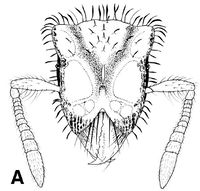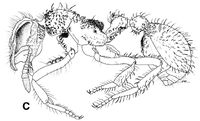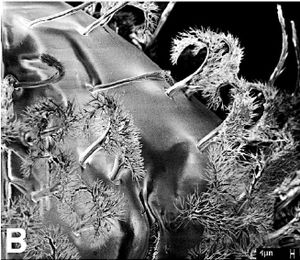Stegomyrmex bensoni
| Stegomyrmex bensoni | |
|---|---|

| |
| Scientific classification | |
| Kingdom: | Animalia |
| Phylum: | Arthropoda |
| Class: | Insecta |
| Order: | Hymenoptera |
| Family: | Formicidae |
| Subfamily: | Myrmicinae |
| Tribe: | Solenopsidini |
| Genus: | Stegomyrmex |
| Species: | S. bensoni |
| Binomial name | |
| Stegomyrmex bensoni Feitosa, Brandão & Diniz, 2008 | |
The single worker type specimen was captured by arachnologist Renata Andrade while searching for cavernicolous pseudoscorpions in Serra dos Carajas, southeastern state of Para (Amazon region), Brazil. Despite this specimen being collected inside a cave, near its mouth, there is no undisputed evidence that Stegomyrmex bensoni is restricted to this habitat. The finding represents the first record of a stegomyrmecine ant in the Amazon Region. (Feitosa et al. 2008)
Identification
Feitosa et al. (2008) - The peculiar multibranched pilosity, allied to the deep metapropodeal groove, and the absence of anteroventral petiolar projections, easily separate this species from all others in the genus.
Keys including this Species
Distribution
Latitudinal Distribution Pattern
Latitudinal Range: -6.746944444° to -6.746944444°.
| North Temperate |
North Subtropical |
Tropical | South Subtropical |
South Temperate |
- Source: AntMaps
Distribution based on Regional Taxon Lists
Neotropical Region: Brazil (type locality).
Distribution based on AntMaps
Distribution based on AntWeb specimens
Check data from AntWeb
Countries Occupied
| Number of countries occupied by this species based on AntWiki Regional Taxon Lists. In general, fewer countries occupied indicates a narrower range, while more countries indicates a more widespread species. |

|
Estimated Abundance
| Relative abundance based on number of AntMaps records per species (this species within the purple bar). Fewer records (to the left) indicates a less abundant/encountered species while more records (to the right) indicates more abundant/encountered species. |

|
Biology
Castes
Known only from the worker caste.
Nomenclature
The following information is derived from Barry Bolton's Online Catalogue of the Ants of the World.
- bensoni. Stegomyrmex bensoni Feitosa, Brandão & Diniz, 2008: 69, figs. 1, 7 (w.) BRAZIL (Pará).
- Type-material: holotype worker.
- Type-locality: Brazil: Pará, Canaãdos Carajás (06°44’49’’S, 50°21’05’’W) (Gruta NV06), 22-28.ii.2005 (Andrade & Arnoni).
- Type-depository: MZSP.
- Distribution: Brazil.
Unless otherwise noted the text for the remainder of this section is reported from the publication that includes the original description.
Description
Worker
HW 1.26; HL 1.09; ML 0.61; SL 0.84;WL 1.77; PL 0.78; PPL 0.45; GL 1.70; TL 6.40; CI 115.56; SI 66.35. Color reddish brown. Basal portion of mandible finely and densely striate, with large and sparse piligerous punctures, apical portion and masticatory border mostly smooth and shining; inner surface of antennal scrobes with fine, dense, transversal and concentric striation; dorsal surface of head predominantly smooth and shining, with scattered punctures near the vertexal border; margin of frontal lobes finely areolate-rugose; central portion of each frontal lobe virtually translucent, so that is possible to observe the inner surface of the antennal scrobes near the insertions of antennae; antennae opaque and finely punctate; lateral and ventral surface of head deeply areolate; occipital face of head smooth and shining except for the nucal collar which is regularly and deeply scrobiculate; mesosoma almost entirely smooth and shining, except for a few scattered punctures at the inferior portion of meso and metapleuron; legs smooth and rather opaque; petiole and postpetiole smooth and shining with some sparse piligerous punctures; dorsum of gaster feebly shining and with sparse and fine punctuation.
Pilosity golden and extremely diverse; sparse filiform hairs covering the dorsum of mandible, external borders of frontal carinae, antenal scapes, legs, dorsum of mesosoma and metasoma; long, slightly curved, moderately clavate hairs present on dorsum of head and promesonotum; short, curved, branched hairs present on head occipital corners, dorsal surface of legs and gaster; posteroventral corners of head, anterior and lateral portions of promesonotum, dorsum of metanotum and propodeum, ventral and lateral faces of waist and anterior portion of gaster (in special the sternite) with aggregations of long, multibranched (plumose), curved hairs, so that the integument is hardly visible in these areas.
Head vertexal margin convex in the middle. Compound eyes exceedingly small, with circa three almost indistinct facets at the maximum diameter.
Promesonotum strongly convex dorsally; metapropodeal groove deeply impressed; propodeal spines short and subtriangular, entirely covered by the propodeum pilosity; propodeal spiracle wide open, and moderately projected laterad; propodeal lobes subquadrate and weakly projected over the petiolar peduncle.
Petiole elongate, slightly arched, with a prominent rounded node; ventral carina of petiolar peduncle without anterior projections. Postpetiole strongly convex dorsally and without ventral processes. Gaster oval and robust.
Type Material
Holotype worker.—BRAZIL: Para, Canaa dos Carajas (06° 44’ 49’’S, 50° 21’ 50” W) (Gruta NV06) 22–28.ii.2005 (Andrade & Arnoni) [[[MZSP|Museu de Zoologia da Universidade de Sao Paulo]]].
Etymology
Species named after the prominent Brazilian-American ecologist, Woodruff Whitman Benson, well known for the study of ecological interactions in Brazilian ecosystems. He organized for several years a field course on Ecology (graduate program of the Universidade Estadual de Campinas, Sao Paulo), given for several years in the Serra dos Carajas, Para, where generations of Brazilian graduate students had their first field experience, and where the unique known specimen of S. bensoni was found.
References
- Albuquerque, E., Prado, L., Andrade-Silva, J., Siqueira, E., Sampaio, K., Alves, D., Brandão, C., Andrade, P., Feitosa, R., Koch, E., Delabie, J., Fernandes, I., Baccaro, F., Souza, J., Almeida, R., Silva, R. 2021. Ants of the State of Pará, Brazil: a historical and comprehensive dataset of a key biodiversity hotspot in the Amazon Basin. Zootaxa 5001, 1–83 (doi:10.11646/zootaxa.5001.1.1).
- Feitosa, R. M., C. R. F. Brandão and J. L. M. Diniz. 2008. Revisionary studies on the enigmatic Neotropical ant genus Stegomyrmex Emery, 1912 (Hymenoptera: Formicidae: Myrmicinae), with the description of two new species. Journal of Hymenoptera Research. 17(1):64-82.

